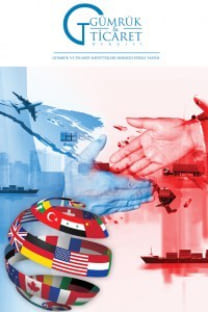Dağıtık Kayıt Teknolojisi
Bilgi, sadece insanlığın sahip olduğu en değerli kaynak değil, aynı zamanda insanın kendisini gerçekleştirmeye çalışırken ihtiyaç duyduğu en önemli enstrümanıdır. Bu anlamda insanlık olarak sahip olduğumuz bilgi birikimini varoluştan beri bu bilgiyi işleyen, kayıt altına alan, paylaşan, sonraki nesillere aktaran ve muhafaza eden yöntemlere borçluyuz. Bu yöntem ve araçlar, insanlığın ulaştığı teknolojik gelişmişlik seviyesine paralel bir şekilde değişmektedir. Bu makalede içinde bulunduğumuz dönemin yeni kayıt teknolojisi olarak adlandırılan Dağıtık Kayıt Teknolojileri genel boyutlarıyla ve kavramsal açıdan irdelenmiştir.
Anahtar Kelimeler:
Dağıtık Kayıt Teknolojisi, Blokzincir, Toplum 5.0
Distributed Ledger Technology
Knowledge is not only the most valuable resource of mankind, but also the most important instrument possessed when trying to realize himself. In this aspect, today we owe our vast knowledge to methods that processes, records, shares, transfers, and preserve this knowledge since its existence. These methods and tools vary in parallel with the level of technological development reached by humanity. In this article the general dimensions of the Distributed Ledger Technology with a conceptual point of view are examined.
Keywords:
Distributed Ledger Technology, Blockchain, Society 5.0,
___
- Hood, M. (1967). The Tartaria Tablets. Antiquity, 41(162), 99-113. doi:10.1017/S0003598X00033032
- Kramer, S. N. (2010). The Sumerians: Their history, culture, and character. University of Chicago Press.
- Speiser, E. (1963). Cuneiform Law and the History of Civilization. Proceedings of the American Philosophical Society, 107(6), 536-541. Retrieved from http://www.jstor.org/stable/986110)
- Hunter, D. (1978). Papermaking: the history and technique of an ancient craft. Courier Corporation.
- Buringh, E & Zanden, J. (2009). Charting the “Rise of the West”: Manuscripts and Printed Books in Europe, A Long-Term Perspective from the Sixth through Eighteenth Centuries. The Journal of Economic History. 69. 409-445. 10.1017/S0022050709000837.
- Umassd, (1861) The Royal Commission on the State of Popular Education in England [Newcastle Commission], Parliamentary Papers, 1861, XXI. pp. 293-328; in G. M. Young and W. D. Hancock, eds., English Historical Documents, XII(1), 1833-1874 New York: Oxford University Press, 1956, pp. 891-97.
- Thomson. A. (1973), The Dynamics of Industrial Revolution, London: Edward Arnold Publisher.
- Hıll. C. (1969), Reformation to Industrial Revolution, England: Penguin Books.
- Laudon, K. C., & Traver, C. G. (2014), p.123-132. E-commerce: business, technology, society.
- WTO, (2018), World Trade Report 2018, Retrieved from https://www.wto.org/english/res_e/publications_e/world_trade_report18_e.pdf
- IDC, (2018), The Digitization of the World From Edge to Core, Retrieved from https://www.seagate.com/files/www-content/our-story/trends/files/idc-seagate-dataage-whitepaper.pdf
- Cabinet Office,(2019) Society 5.0, Retrieved from https://www8.cao.go.jp/cstp/english/society5_0/index.html
- World Bank Group, (2017), Distributed Ledger Technology (DLT) and Blockchain Retrieved from: http://documents.worldbank.org/curated/en/177911513714062215/pdf/122140-WP-PUBLIC-Distributed-Ledger-Technology-and-Blockchain-Fintech-Notes.pdf
- Buterik. V, (2017). The Meaning of Decentralization Retrieved from: https://medium.com/@VitalikButerin/the-meaning-of-decentralization-a0c92b76a274
- Ganne, E. (2018). Can Blockchain revolutionize international trade?. World Trade Organization. Retrieved from: https://tradenews.com.ar/wp-content/uploads/2018/12/Blockchain-OMC.pdf
- Popov, S. (2016). The tangle. cit. on, 131. Retrieved from http://www.descryptions.com/Iota.pdf
- Baird, L. (2016). The swirlds hashgraph consensus algorithm: Fair, fast, byzantine fault tolerance. Swirlds Tech Reports SWIRLDS-TR-2016-01, Tech. Rep. Retrieved from: http://pages.cpsc.ucalgary.ca/~joel.reardon/blockchain/readings/hashgraph.pdf
- Harris-Braun, E., Luck, N., & Brock, A. (2018). Holochain-scalable agentcentric distributed computing. Alpha, 1, 1-14. Retrieved from: https://github.com/Holochain/holochain-proto/blob/whitepaper/holochain.pdf
- Anwar. H.,(2019). Distributed Ledger Technology: Where Technological Revolution Starts, Retrieved from: https://101blockchains.com/distributed-ledger-technology-dlt/ Nakamoto, S. (2008). Bitcoin: A peer-to-peer electronic cash System, Retrieved from: https://s3.amazonaws.com/academia.edu.documents/54517945/Bitcoin_paper_Original_2.pdf? AWSAccessKeyId=AKIAIWOWYYGZ2Y53UL3A&Expires=1552951723&Signature=ACwvVxb5CCnAUo4nhu8Tv1beiv8%3D&response-content-disposition=inline%3B%20filename%3DBitcoin_A_Peer-to-Peer_Electronic_Cash_S.pdf
- Buterin, V. (2014). Ethereum white paper: a next generation smart contract & decentralized application platform. First version. Retrieved from: http://blockchainlab.com/pdf/Ethereum_white_paper-a_next_generation_smart_contract_and_decentralized_application_platform-vitalik-buterin.pdf
- Anwar.H, (2018b),The Ultimate Blockchain Technology Guide: A Revolution to Change the World, Retrieved from: (https://101blockchains.com/ultimate-blockchain-technology-guide/).
- Alam. I,(2018), What are Ricardian Contracts? A Complete Guide, Retrieved from: https://101blockchains.com/ricardian-contracts/
- Grigg, I. (2000, February). Financial cryptography in 7 layers. In International Conference on Financial Cryptography (pp. 332-348). Springer, Berlin, Heidelberg. Retrieved from: https://link.springer.com/chapter/10.1007/3-540-45472-1_23
- Schwartz, D., Youngs, N., & Britto, A. (2014). The ripple protocol consensus algorithm. Ripple Labs Inc White Paper, 5. Retrieved from: https://www.cryptiaexchange.com/Whitepaper_Ripple.pdf
- EUBlockchain, (2019), Scalability,interopatibility, and sustainability of blockchains. Retrieved from: https://www.eublockchainforum.eu/sites/default/files/reports/report_scalaibility_06_03_2019.pdf
- Yayın Aralığı: Yılda 4 Sayı
- Başlangıç: 2013
- Yayıncı: Gümrük ve Ticaret Müfettişleri Derneği
